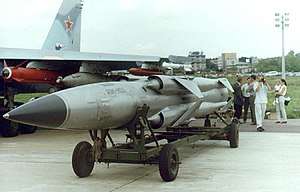SS-N-22
SS-N-22 Sunburn is the NATO reporting name for two unrelated Soviet anti-ship missiles. Although the missiles were very different, distinguishing between them is difficult because their ship-mounted launching containers were identical. Confusion was exacerbated by the Soviet practice of mixing missile types within a class of ships. It was therefore not confirmed that the "SS-N-22" actually referenced two different missiles until after the fall of the Soviet Union.
Chelomei rocket
One of the SS-N-22s was the P-80 Zubr, designed by a team led by Vladimir Chelomei. The Zubr was rocket-propelled and armed with a 250 kilogram warhead. It was carried by early-model Sovremenny-class destroyers and Tarantul-class corvettes. The submarine-launched version of this missile was also designated as an SS-N-22 Sunburn by NATO but was known to the Soviets as the P-100 Oniks.
MKB Raduga model

The other, unrelated SS-N-22 was the Raduga P-270 Moskit. It was ramjet-propelled (though launched by a small solid-fuel rocket), and was carried by later-model Sovremenny class destroyers, Tarantul class corvettes, and several smaller warships. This weapon has a top speed of Mach 3.[1] The high speed of the missile means a typical response time for the target of only 25 to 30 seconds, giving a target little time to react. Moskit can be armed with a warhead of 320 kg.[2]
Another version of this weapon is called the ASM-MMS;[3] it is intended to be launched by a Su-33.
The People's Republic of China acquired SS-N-22 launchers and missiles (specifically, the for-export 3M-80E Moskit variant) with a 1999–2000 purchase of two Sovremenny destroyers from Russia.According to Russia, the PRC funded the development of the SS-N-22 version for the People's Liberation Army Navy (PLAN). It has the designation 3M-80MBE, and this version differs from earlier versions mainly in having increased range (now beyond 220 km; 240 km has been quoted). These new missiles will be first installed on board the second pair of Sovremenny class destroyers. A total of 500 SS-N-22 AShM were ordered by the PRC for the four Russian-built Sovremenny class destroyers. With the exception of the first 20, these are the 3M-80MBE variant. The PRC has stockpiled roughly 15 SS-N-22 missiles per launch tube (each destroyer having a total of 8 launchers in two quadruple configurations). It is speculated that the PLAN intends to use the missiles against carrier battle groups deployed by the United States Navy in the event of a confrontation with the Republic of China (Taiwan).[4]
Six SS-N-22 launchers were also present on the Soviet ekranoplan Lun.
Operators
References
- "Moskit / SS-N-22 Sunburn". Retrieved 1 October 2014.
- "Moskit / SS-N-22 Sunburn". Retrieved 1 October 2014.
- John Pike. "Moskit / SS-N-22 Sunburn". Retrieved 1 October 2014.
- "CHINA'S "TSUSHIMA" ANTICARRIER STRATEGY". The Jamestown Foundation. Retrieved 1 October 2014.
- Cordesman,A. and Kleiber, M. (2007, Iran's Military Forces and Warfighting Capabilities, Washington: Centre of Strategic and International Studies.
- "Egyptian Navy received Russian 3M80 Moskit anti-ship missiles for its Tarantul-class corvette". Navy Recognition. Retrieved 2018-05-06.
See also
- Goalkeeper close-in weapon system (CIWS), a countermeasure to anti-ship missiles
External links
- Moskit/SS-N-22 Sunburn on GlobalSecurity.org
- Moskit/SS-N-22 Sunburn Photoalbum on Bora-Class.info
- Project 671 Victor class Attack Submarine (Nuclear Powered) on GlobalSecurity.org
- Project 945 Sierra class Attack Submarine (Nuclear Powered) on GlobalSecurity.org
- 3M55 Oniks / P-800 Yakhont / P-800 Bolid / SSN-X-26 on GlobalSecurity.org
- Counter Measure, Goalkeeper close-in weapon system on en.wikipedia.org
- CHINA'S "TSUSHIMA" ANTICARRIER STRATEGY on jamestown.org